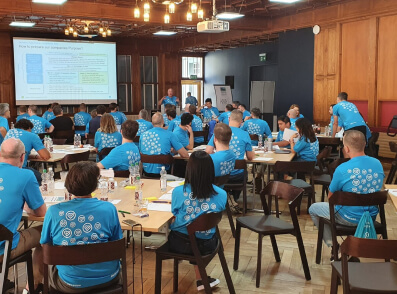As we’re over halfway through our Wheel of LifeTM series, this week we’re going to talk about physical activity.
Being physically active has a surprising number of benefits, as you’ll discover below. Hence why the WHO has set very precise guidelines on how much physical activity everybody around the world should be getting. They recommend adults to achieve at least 150–300 minutes of moderate-intensity activity per week.
However, we are sadly not meeting these guidelines.
60 to 85% of people in the world—from both developed and developing countries—lead sedentary lifestyles.
Being insufficiently active is one of the most serious yet poorly addressed public health problems of our time. Keep on reading to find out how sedentarism is affecting our health and what can be done about it.
The Risks Of A Sedentary Lifestyle
The lack of physical activity presents many health risks that are affecting an increasing number of people worldwide.
One of the more obvious risks is weight gain. As our bodies remain still, we burn fewer calories and our muscle mass decreases, therefore burning less calories. Sedentary lifestyles are also known to affect our metabolism, making it harder for our bodies to break down fats and sugars.
A sedentary lifestyle is among the leading causes of death and disability in the world.
Additionally, lack of exercise leads to a wide range of chronic diseases, and premature deaths, such as:
- Obesity
- Heart diseases, including coronary artery disease and heart attack
- High blood pressure
- High cholesterol
- Stroke
- Metabolic syndrome
- Type 2 diabetes
- Certain cancers, including colon, breast, and uterine cancers
- Osteoporosis and falls
- Increased feelings of depression and anxiety
When looking at the bigger picture, physical inactivity along with increasing tobacco use and poor diet and nutrition, are propelling the rapid rise of chronic diseases such as the ones stated above. These conditions are now the leading causes of death in almost every corner of world. The good news is that they are, for the most part, completely preventable through lifestyle changes.
More Than Just Exercise
As mentioned previously, the consequences of leading an inactive lifestyle are severe.
However, being physically active can combat those health risks.
It is never too late to start benefitting from a number of advantages that come with regular physical exercise:
- Reduced risk of dying from coronary heart disease and of developing high blood pressure, colon cancer, and diabetes.
- Can help reduce blood pressure in some people with hypertension.
- Helps maintain healthy bones, muscles, and joints.
- Reduced symptoms of anxiety and depression.
- Helps control weight, develop lean muscle, and reduce body fat.
Exercising regularly also promotes better sleep. It can enhance the quality and quantity of our sleep and also help us fall asleep faster. However, to avoid being too alert, experts recommend not to exercise too close to our bedtimes.
A Lifestyle Solution
What we know now is that a holistic solution must be put in place to combat the severe health risks linked to sedentarism. At dacadoo, we are proposing a completely holistic approach to lifestyle navigation, with our newly announced Wheel of LifeTM Digital Health Engagement Platform (DHEP).

Within our DHEP, users can actively engage in healthier lifestyles through a combination of gamification, expert-curated content, our smart digital coach (which is available 24/7) and social networking features.
During onboarding, users will be asked how active they are. Over time, the system will calculate an accurate score for their activity, which helps users see and analyze at a glance their physical activity level.
Supporting over 115 physical activities –more than any other similar platforms–, Wheel of LifeTM allows users to track them in a variety of ways. One of our most attractive features is our integrated activity tracker to directly track a range of outdoor activities (GPS tracking being optional) and indoor activities, without the need to connect a device and eliminating the hassle of manual input. Although naturally, there are options to connect wearables, third-party apps and even manual input should the user wish to do so.
To keep users motivated and engaged with our platform, we have a series of exciting achievements that the user will be awarded as they progress through their activity journey. Additionally, our digital coach will provide personalized summaries to users, so they are aware of how much they moved over a period of time.
Depending on their activity and fitness levels, users will be recommended a series of physical activity goals, such as running, walking or cycling. These goals have been designed by our team of specialists in order to motivate users into not only exercising sporadically, but into improving once and for all their physical activity routines.
From the insurer perspective, improving your policyholders’ physical activity will put them at lesser risk of developing severe chronic conditions, saving you not only healthcare costs, but also time spent managing claims. Build a relationship with your members based on trust, while boosting member loyalty and retention.
Implementing Wheel of LifeTM for corporate wellness will ensure that your employees stay healthy and active, minimizing sick leave and increasing productivity and concentration at work. A healthy workforce is the best engine for your business to thrive!
Let’s get your digital health engagement plan in place.
Request a complimentary Wheel of LifeTM demo today.
Every week we will be releasing a dedicated article on one of the seven different categories of our Wheel of LifeTM. Come back on January 7th to read our next blog on the self-control category!






















